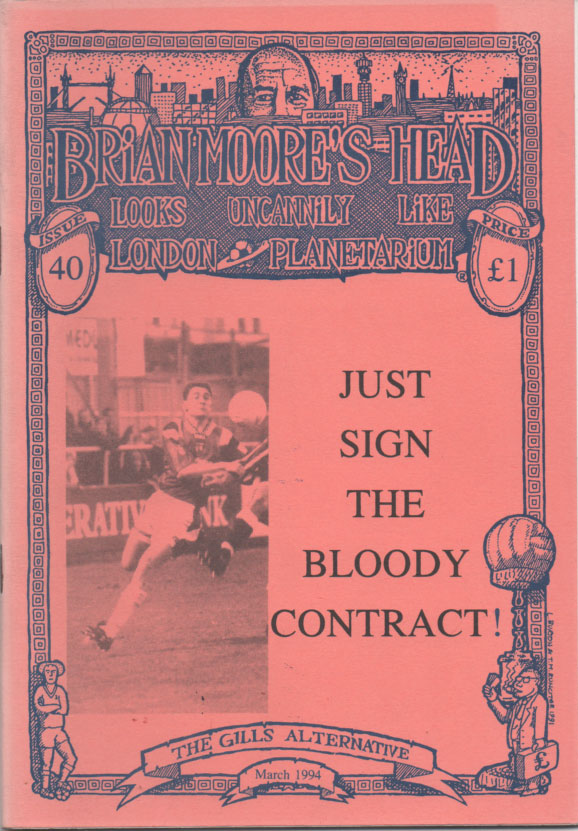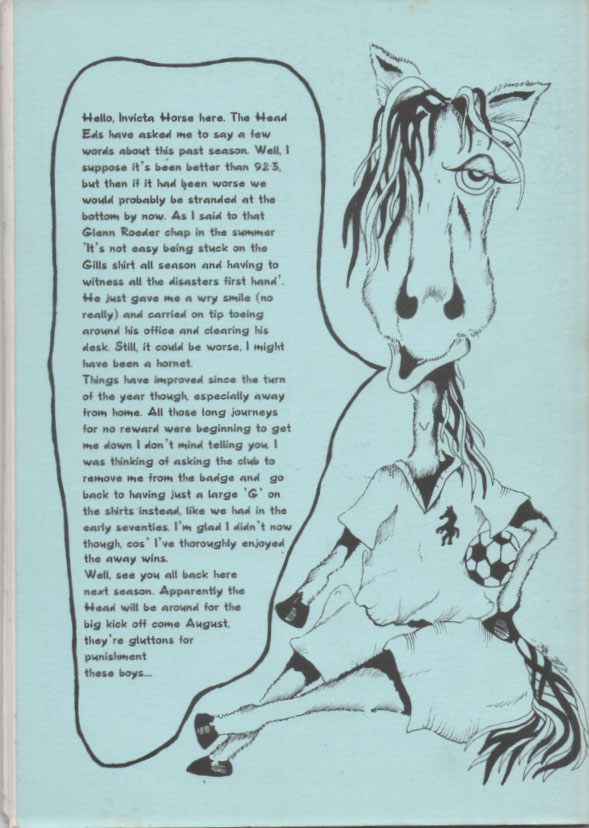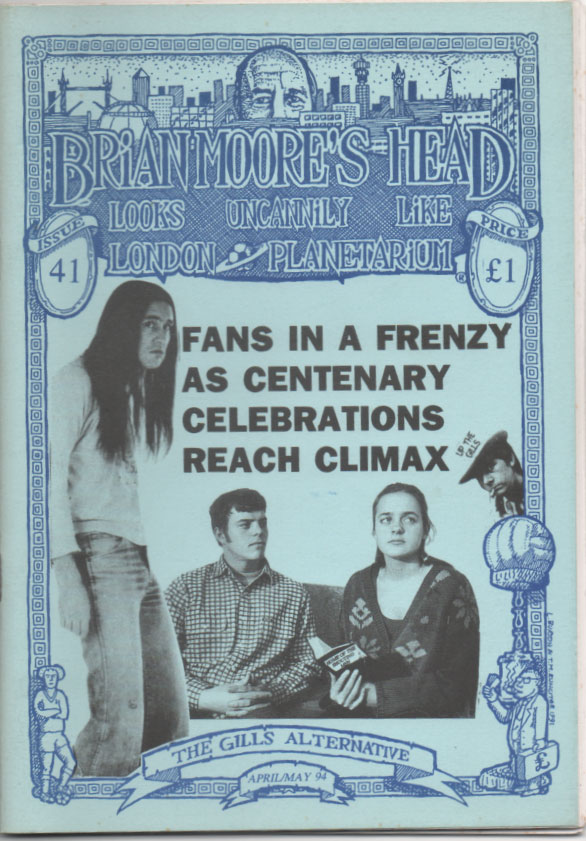Gillingham lost 2-0 at home to Shrewsbury Town on Saturday 12 March 1994, with the attendance of just 3,038 a major contributory factor for poor sales that afternoon of BMH40, available for the first time at the match.
The editorial bemoaned the lack of goals being scored by the Gills, February having seen the club manage just two in four fixtures, but they were enough to pick up a point apiece from two draws, with the other two games ending in defeat.
Top scorer at the time was Nicky Forster who, having managed eleven goals before the turn of the year, had contributed two since the beginning of 1994. The forward had been stalling on a new deal to stay at the club, with the cover of BMH40 imploring him to sign the contract he had been offered.
The editorial included, ‘Now that the ventriloquist’s dummy, Nicky Forster (it seems he is being worked by his agent, Eric Hall, at the moment, judging by the “agents-speak” he has been coming out with) doesn’t seem too bothered about playing for Gills (maybe he can’t see the goal for the pound signs in front of his eyes), we need goals from elsewhere.’ The whole team was subject to criticism, with insufficient goals from the other strikers, Paul Baker and Liburd Henry, and a pitiful goalscoring return from the regular midfield quartet of Richard Carpenter, Gary Micklewhite, Neil Smith and Neil Smillie. On the day BMH40 was launched, those four midfielders had managed a combined total of five goals from one hundred and ten appearances in 1993-94, with the club’s total just thirty-three from thirty-one fixtures.

Issue thirty-nine included an article, ‘Have we got a video?’, that started, ‘Much has been said and written about the Gills’ Centenary video, the majority of it uncomplimentary, but how many of those who have been so quick to criticise have actually seen it.’ The author had watched it, although he hadn’t actually bought one, he had simply borrowed a copy off an unfortunate fan who had paid out for a copy. The writer believed that it was time to redress the balance and explode a few myths, ‘Firstly, I would like to bury, once and for all, the lie that there is no action on the video.
Completely untrue, there is lots of action, ranging from shots of the Gills’ squad training on the Garrison Ground, to Community Officer Phil Attfield taking a group of youngsters for training at the Priestfield Sports Complex. There is also rare footage of the entire Board of Directors, dressed in period costume following the re-enactment of the inaugural Board meeting in the Napier Arms, having a kickabout in a field. And, as if all this was not enough, a good twenty seconds of action from the game against Chesterfield, including a Richard Carpenter twenty-five-yard thunderbolt which he surprisingly fails to get on target. It is also absolutely incorrect to state that there are no goals on the video, as one of the youngsters at the Sports Centre is clearly seen smacking the ball high into the rigging of a six-a-side goal inside the complex.’
The start of the video was a sequence of a flight over the River Medway, heading across Gillingham towards Priestfield Stadium, and there had been some complaints that the camerawork for this section of footage had been on the jerky side, ‘but, personally, I feel this is understandable, as the cameraman tries to control his excitement as he nears Priestfield and, to date, I have received no confirmed reports of anyone actually being airsick whilst watching this portion of the film, just a lot of unsubstantiated gossip, surely put about by malicious rumourmongers out to discredit the club.
And how can anyone complain about the interview conducted with (club historian) Roger Triggs on the hallowed turf, where he tells us of Jimmy Scarth’s two and a half minute hat-trick “on this very ground” and of the 23,000 crowd that assembled for a Cup tie against QPR “on this very ground”, not to mention all the great players who have played for the Gills “on this very ground”.’ There was also footage filmed inside the Napier Arms itself, with shots of the plaques commemorating the formation of the club in said establishment, with the narrator reading them out to the viewer. The review concluded with, ‘All in all, this half hour of top-level entertainment is surely worth a tenner of anyone’s money and is a fitting tribute to a football club that has achieved so much in its first 100 years, and stands throughout the footballing world for total professionalism.’
Having had enough trouble trying to sell BMH40 for the first time at a match that drew just over 3,000 fans, BMH41 was launched on 23 Saturday April, at the home fixture against Mansfield Town, with only 2,390 in attendance. ‘The Story of the Gills’, which contained a heady mixture of the truth and the blatantly made up, reached its eighth and final instalment in issue forty-one. At a time when many football grounds were undergoing extensive renovation, following the 1985 Bradford fire and Hillsborough disaster four years later, the article noted that, at Priestfield, ‘the only noticeable improvement in the whole place in the last ten years, aside from the removal of the Rainham End fence, is the Lord Sondes clock.
It doesn’t always seem to tell the correct time, referees tend to ignore it completely, the light doesn’t always work and, in terms of entertainment, it ranks well behind the one in the main square of Trumpton, but it is the club’s one contribution to the improvement of spectator facilities in the last twenty years.’ The story was brought up-to-date with the 1993-94 season and another inevitable mention for a certain item of merchandise, ‘Part of the “less than extremely exciting” official Gills centenary celebrations involved the production of a Centenary video, which has been described as “a waste of money”, “a waste of magnetic oxide particles”, “a sensitive study of one woman’s bid to influence British foreign policy on India in the nineteenth century” (by someone watching the wrong video) and “a gripping in-depth account of 100 years of the club’s history, featuring three hours of goals, match highlights and interviews with players past and present” (by someone in a dream).’
Never afraid to rewrite the club’s history, the writer covered the incident at the Bank Holiday home match against Northampton at the end of 1993 when the Monday afternoon kick-off had been delayed as the timer for the floodlights had been set for an evening fixture, leading to the need of the services of an electrician for re-setting, as follows, ‘By 1993, Gillingham had become the first League club to have installed floodlights powered by the controversial cold water fusion technology, invented by Professor Martin Fleischmann and Dr Stanley Pons. Sadly, just before the Christmas game against Northampton Town, somebody dropped and cracked the palladium electrode and then the cold water inadvertently got warmed up. The fusion process failed to work and the bumper seasonal crowd had to wait around before an electrician could be found to jump-start the lights from a conventionally-powered house in Gordon Road.’ The series ended with, ‘In BMH number 773, we will bring you “The Story of the Gills – the second hundred years, Part One”. We will also be poking fun at the club for the official Bi-Centenary book’s failure to appear on schedule”.’
On Easter Saturday, Gillingham played away at Northampton and the BMH team had arranged a match for that morning against fans of the Cobblers on a local park pitch, which explained why we were at Northampton station at 10am. Four of us had driven up and were awaiting the arrival of the contingent who were letting the train take the strain. When they arrived, there were fewer of them than had been expected. The train they were on, scheduled to stop at Rochester (where other team members were to get on), had failed to do so, leaving most of our proposed forward line and midfield on the platform, watching the train that they had intended to catch sail on towards London.

We considered, with our hosts, what to do and decided on a later kick-off and shorter match to allow our delayed players time to arrive. It had been a glorious morning weather-wise as we’d journeyed up to Northampton, ‘but by the time we took our first tentative steps on to the muddy quagmire, a real glue-pot of a pitch, it was overcast and the wind was stronger.’ There was an adjacent pitch that looked in better condition ‘but the archery that was going on near one end persuaded us that it might not be too clever an idea to use that one.’
After an even start, we let in a goal due to a defensive mix-up, then conceded another before half time. It seemed that our forwards mirrored those of the Gills, ‘Up front, it was the same old story as our 1-0 defeat against the team of Carlisle fans the previous week, we just couldn’t score, despite a fair amount of possession.’ We had a thirteen-man squad, with the plan being for regular substitutions, however, ‘it didn’t really work out that way though. Once Rob had gone off, we couldn’t get him back on again – he preferred to stand on the touchline and drink bitter – so we were down to twelve.
Then, not long after half time, John injured his wrist (it turned out to be broken, which he didn’t find out until he went to get it checked out at the hospital the following day) and went off, playing no further part. So it was down to the remaining eleven of us to restore some pride and turn round the half-time deficit. We failed miserably. Three more goals were conceded, with Chris blamed for the first of these, even though he wasn’t on the pitch when it was scored. At the time, he was running the line and he failed miserably to flag about three of their players offside before one of them slotted home. As we slid and slithered in the mudbath, the conditions got even worse, the sleet and snow being the final insult. In the end, seeing as we managed to concede five goals in an hour, it was probably a blessing that we didn’t play the full ninety minutes. So we lost 5-0 and hoped that there wouldn’t be a repeat that afternoon.’
The Gills won 2-1 in what was their last visit to the County Ground, goals from Richard Carpenter, rarity value in itself but the fact that he scored direct from a free-kick made it a collectors’ item, and Nicky Forster, in a two-minute spell just after the hour mark, gave us a 2-0 lead, the first time in two and a half years that we had held a two goal advantage in an away league game. There was the inevitable late goal from the home side, in the third minute of stoppage time, leading to a final onslaught and the Cobblers winning a corner that we managed to hack away. The final whistle blew soon after and the Gills had won on their travels for the fourth time in 1993-94. After heading to a pub to watch Blackburn’s match against Manchester United, a group of us made for London, the Venue in New Cross to be exact, to attend a gig by Half Man Half Biscuit, whose set included Dickie Davies’ Eyes, the track whose lyrics had provided the full name of the fanzine.
Copies of BMH40 had come with a membership form for the new Gills Supporters Club and issue 41 explained why, ‘Amidst deafening cries of “sell out!”, we would like to point out that, no, we didn’t get paid for including it, we did it out of the goodness of our hearts, and because we think the new organisation is a good idea. The main reasons why we think it is a good idea are simple. For a start, it will hopefully go some way towards getting rid of the little cliques that have been a feature of the Gillingham support for so long. Now that members of the Blues Supporters’ Association, Social Club and Travel Club(s) have been brought under the umbrella of one organisation, there is no need for the ‘them and us’ situation that some people seem to have been determined to keep alive.
Secondly, a fan-based organisation has to have a large membership if it is to have any relevance outside its own small circle. None of the other organisations could claim to represent the Gillingham support – a Supporters’ Association with 1,000 members (the total the club are hoping for) would be able to do just that.’ BMH acknowledged that the £8 membership was a lot, in addition to the cost of shelling out to watch the team, week-in, week-out, ‘but maybe the benefit, both for the individual and for the Gillingham support as a whole, outweigh such concerns. It’s a matter of personal choice whether you join or not, but whatever you do you’re sending a message to the board, either “Yes. I want a say in the way this club is run” or, “No, I’m not interested, just get on with it yourselves”.
BMH41 was the eighth and final edition of 93-4, with each having had at least forty-eight pages, ‘The decision to do two extra issues certainly helped the cash-flow situation, which was the main reason for the decision, and avoided the necessity of scrabbling around for money to pay the printers. Hopefully there has been no drop in quality, although we have to admit that the tone has been a bit too depressing this season. You should find this particular issue to be rather more upbeat in outlook and we are genuinely looking forward to 1994-95 with some optimism. We will once again be endeavouring to produce another eight Heads in what will be our seventh season, maybe one year we will be able to reflect on a successful one.’
